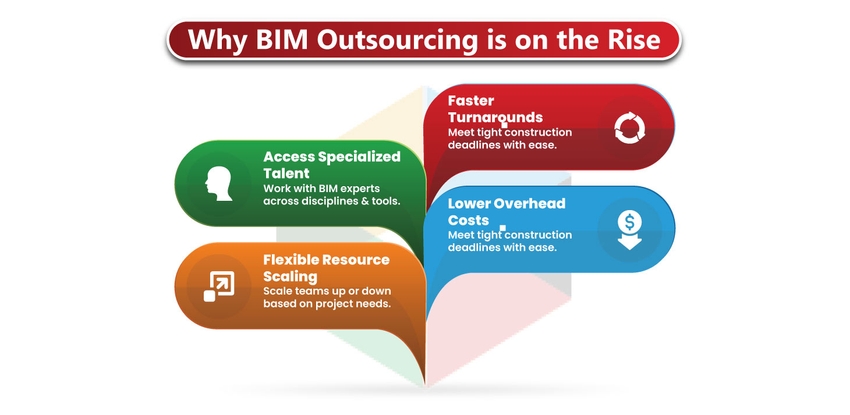
In today’s fast-paced construction industry, the design phase lays the foundation for a project’s overall success. From structural integrity to cost control, everything hinges on how accurately and efficiently a project is planned. As buildings become more complex, traditional design methods often fall short in meeting the precision and coordination demands of modern construction.
This is where digital construction solutions like Building Information Modeling (BIM) come into play. BIM enables the creation of intelligent 3D models that integrate architectural, structural, and MEP components, offering a unified and data-rich environment. These models not only enhance visualization but also streamline communication between stakeholders, reduce clashes, and improve decision-making across the project lifecycle.
For general contractors managing tight schedules and multidisciplinary teams, leveraging BIM outsourcing services has become a strategic move. By outsourcing to experts skilled in Revit BIM modeling for construction and MEP BIM services, contractors can ensure higher accuracy, reduce rework, and optimize overall project delivery. Whether it’s a residential high-rise or a commercial complex, integrating BIM early in the process drives efficiency and minimizes costly surprises down the line.
What is BIM and Why It Matters to General Contractors
Building Information Modeling (BIM) is an intelligent process that enables the creation of highly detailed, data-rich 3D models of a building’s architecture, structure, and systems. Unlike traditional CAD workflows, BIM allows teams to simulate the entire construction process digitally, offering not just geometry but critical metadata, schedules, and cost estimates.

Using platforms like Revit modeling for construction, BIM integrates all disciplines, such as architectural, structural, and MEP BIM services, into a single collaborative environment. This centralized model ensures that everyone involved in the project is working with the most accurate and up-to-date information at all times.
For general contractors, BIM is a powerful tool to improve planning, coordination, and execution on-site.
Here’s why BIM is essential for general contractors:
- Centralized Project Data: All drawings, quantities, and schedules are linked to a single model, reducing miscommunication.
- Clash Detection: Detect design conflicts early, particularly between structural and MEP systems, before they reach the site.
- Improved Accuracy: High levels of detailing reduce human error and eliminate guesswork.
- Faster Decision-Making: Real-time updates and visualizations support better stakeholder communication.
- Lifecycle Support: BIM data is useful not just during construction, but also for operations and maintenance after handover.
By embracing BIM, general contractors can significantly improve construction quality, reduce project delays, and deliver better value to clients, especially in today’s complex and fast-paced AEC landscape.
The Rise of BIM Outsourcing Services
The construction industry is undergoing a rapid digital transformation, and BIM outsourcing services are at the forefront of this shift. As projects become more technically demanding, general contractors are moving away from traditional in-house modeling and embracing outsourcing as a practical and scalable alternative.
Outsourced BIM teams are equipped with specialized tools and software, like Revit BIM modeling for construction and coordination platforms for MEP BIM services. These teams bring proven workflows, multidisciplinary expertise, and the ability to deliver high-quality models that align with global standards.

For general contractors aiming to stay competitive in today’s fast-moving AEC ecosystem, outsourcing BIM is no longer just a cost-saving option—it’s a strategic move to stay agile, deliver faster, and maintain high standards of construction accuracy.
Why General Contractors Should Consider BIM Outsourcing – Key Benefits
In an industry where time, accuracy, and efficiency directly impact profitability, BIM outsourcing services offer general contractors a strategic edge. By delegating BIM tasks to specialized external teams, contractors can focus more on project execution while benefiting from precision-driven digital models that enhance collaboration across disciplines.
Outsourcing BIM tasks to skilled professionals offers general contractors a competitive advantage across the entire project lifecycle. From early-stage design coordination to construction execution, BIM outsourcing services deliver measurable benefits in quality, speed, and scalability.
Key benefits include:
- Improved Coordination & Clash Detection: By integrating architectural, structural, and MEP BIM services into a centralized model, contractors can detect design conflicts early, avoiding costly onsite clashes and rework.
- Enhanced Visualization & Communication: Outsourced teams skilled in Revit BIM modeling for construction produce detailed 3D models and visual outputs that aid in stakeholder alignment and faster approvals.
- Time Savings & Risk Reduction: Delegating BIM production reduces internal workload and project delays. With streamlined workflows and standardized modeling protocols, risk is minimized at every stage.
- Scalable Resources for Any Project Size: Whether handling a single mid-rise or managing multiple large-scale developments, outsourcing allows contractors to scale BIM capacity without overextending internal teams.
With the right BIM partner, general contractors can improve project predictability, reduce overhead, and deliver consistent results across diverse project portfolios. BIM outsourcing services are no longer just an operational choice; they’re a strategic imperative for modern construction success.
Key BIM Outsourcing Services for General Contractors
General contractors managing complex construction workflows can gain significant value by partnering with experts who specialize in BIM outsourcing services. These service providers bring a multidisciplinary team of BIM engineers, architects, and modelers with proficiency in Revit BIM modeling for construction and MEP BIM services, enabling contractors to execute projects with precision, speed, and control.
Here are the most critical BIM services contractors can leverage through outsourcing:
3D Modeling & Visualization
Develop detailed and coordinated 3D models that integrate architectural, structural, and MEP elements. Enhanced visualization improves design clarity, aids decision-making, and supports stakeholder communication.
Clash Detection & Coordination
Identify and resolve inter-disciplinary conflicts early in the design phase, especially between structural and MEP systems, reducing change orders, delays, and on-site rework.
4D BIM Scheduling
Link model components with construction timelines to simulate the entire building sequence. This helps contractors plan phasing, site logistics, and resource allocation more effectively.
5D BIM Cost Estimation
Integrate quantity takeoffs and cost data into the model, providing accurate and real-time budgeting insight that supports value engineering and financial planning.
As-Built Models & Shop Drawings
Generate precise shop drawings and updated as-built documentation based on actual site conditions, essential for construction, handover, and compliance.
Facility Management Support
Extend the model's value into the post-construction phase by embedding asset data, O&M manuals, and maintenance schedules for long-term facility management.
With the right BIM outsourcing services partner, contractors gain access to specialized skills, tools, and workflows that enable smarter, faster, and more coordinated project delivery.
Choosing the Right BIM Outsourcing Partner
While BIM outsourcing services offer immense value, their effectiveness depends largely on choosing the right partner. A reliable BIM partner is not just a vendor; they become an extension of your project team, working in sync with your goals, timelines, and standards.
Here are key factors to consider when evaluating a BIM outsourcing partner:
Domain Expertise
Look for firms with deep experience e in your specific project type, like residential, commercial, infrastructure, or healthcare. Their familiarity with industry standards and regional codes can significantly streamline coordination and compliance.
Technology Stack & Software Proficiency
Ensure the team is proficient in industry-leading tools such as Revit, Navisworks, AutoCAD, and other relevant platforms. A competent partner will also offer specialized MEP BIM services to ensure seamless integration across trades.
Proven Portfolio
Review case studies, client references, and sample models. A track record of successfully delivered BIM projects across various disciplines demonstrates reliability and capability.
Project-Specific Understanding
The right partner takes the time to understand your scope, LOD (Level of Development) requirements, delivery timelines, and coordination goals. Avoid one-size-fits-all providers.
Clear Communication & Workflow Alignment
Successful BIM collaboration depends on structured communication, defined review cycles, and shared standards. Choose a partner that offers flexible engagement models and uses collaborative platforms to stay in sync with your team.

By selecting a BIM partner who aligns with your project vision and workflow, you can maximize the benefits of outsourcing, from faster delivery to improved model accuracy. Choose a firm that doesn’t just deliver BIM files but delivers results.
Key Challenges of BIM Outsourcing and How to Fix Them
While BIM outsourcing services offer immense benefits, they’re not without challenges. Here’s how general contractors can identify and overcome common issues to ensure successful project delivery.
| Challenge | Impact | Solution |
|---|---|---|
| Communication Gaps | Misunderstandings, delays, and rework | Establish regular check-ins, use collaborative platforms, and clarify expectations |
| Quality Inconsistency | Inaccurate models or deliverables that don’t meet project needs | Define modeling standards and run a pilot before full-scale engagement |
| Lack of Project Understanding | Deliverables misaligned with design intent or construction goals | Provide clear design context, BEP, and conduct onboarding sessions |
| Data Security Concerns | Risk of IP theft or unauthorized access to sensitive project data | Work with vendors using secure protocols, NDAs, and certified workflows |
| Time Zone Differences | Reduced responsiveness and collaboration delays | Ensure overlapping work hours and assign a project coordinator on both ends |
With the right planning and alignment, BIM outsourcing services can become a seamless extension of your delivery workflow, maximizing quality, speed, and cost-efficiency.
Conclusion
BIM outsourcing services offer a powerful edge to contractors seeking faster delivery, reduced risk, and higher precision across the project lifecycle. From detailed Revit BIM modeling for construction to advanced coordination through MEP BIM services, outsourcing enables teams to leverage expert capabilities without increasing overhead. It streamlines workflows, improves collaboration, and ensures accurate, data-rich outputs.
For forward-thinking contractors, outsourcing isn’t just a cost-saving tactic; it’s a strategic move to stay agile, competitive, and future-ready in an increasingly digital construction environment. Embracing BIM outsourcing unlocks smarter, more efficient project execution from start to finish.
Need a BIM partner you can rely on?




